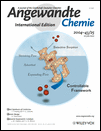Sol–Gel Reaction Using DNA as a Template: An Attempt Toward Transcription of DNA into Inorganic Materials
Munenori Numata Dr.
Department of Chemistry and Biochemistry, Graduate School of Engineering, Kyushu University, Fukuoka 812–8581, Japan, Fax: (+81) 92-642-3611
Search for more papers by this authorKazunori Sugiyasu
Department of Chemistry and Biochemistry, Graduate School of Engineering, Kyushu University, Fukuoka 812–8581, Japan, Fax: (+81) 92-642-3611
Search for more papers by this authorTeruaki Hasegawa Dr.
Department of Chemistry and Biochemistry, Graduate School of Engineering, Kyushu University, Fukuoka 812–8581, Japan, Fax: (+81) 92-642-3611
Search for more papers by this authorSeiji Shinkai Prof.
Department of Chemistry and Biochemistry, Graduate School of Engineering, Kyushu University, Fukuoka 812–8581, Japan, Fax: (+81) 92-642-3611
Search for more papers by this authorMunenori Numata Dr.
Department of Chemistry and Biochemistry, Graduate School of Engineering, Kyushu University, Fukuoka 812–8581, Japan, Fax: (+81) 92-642-3611
Search for more papers by this authorKazunori Sugiyasu
Department of Chemistry and Biochemistry, Graduate School of Engineering, Kyushu University, Fukuoka 812–8581, Japan, Fax: (+81) 92-642-3611
Search for more papers by this authorTeruaki Hasegawa Dr.
Department of Chemistry and Biochemistry, Graduate School of Engineering, Kyushu University, Fukuoka 812–8581, Japan, Fax: (+81) 92-642-3611
Search for more papers by this authorSeiji Shinkai Prof.
Department of Chemistry and Biochemistry, Graduate School of Engineering, Kyushu University, Fukuoka 812–8581, Japan, Fax: (+81) 92-642-3611
Search for more papers by this authorGraphical Abstract
The topologically different structures in plasmid DNA can be successfully transcribed into silica structures by using the DNA as a template for sol–gel polycondensation of tetraethoxysilane after treatment by two cation-exchange steps (see scheme). These findings imply that the different ordered silica structures can be created from the same template through its higher-order conformational changes.
Supporting Information
Supporting information for this article is available on the WWW under http://www.wiley-vch.de/contents/jc_2002/2004/z54009_s.pdf or from the author.
Please note: The publisher is not responsible for the content or functionality of any supporting information supplied by the authors. Any queries (other than missing content) should be directed to the corresponding author for the article.
References
- 1For recent reviews, see
- 1aN. K. Raman, M. T. Anderson, C. J. Brinker, Chem. Mater. 1996, 8, 1682;
- 1bS. Mann, S. L. Burkett, S. A. Davis, C. E. Fowler, N. H. Mendelson, S. D. Sims, D. Walsh, N. T. Whilton, Chem. Mater. 1997, 9, 2300;
- 1cL. A. Estroff, A. D. Hamilton, Chem. Mater. 2001, 13, 3227;
- 1dS. A. Davis, M. Breulmann, K. H. Rhodes, B. Zhang, S. Mann, Chem. Mater. 2001, 13, 3218;
- 1eR. A. Caruso, M. Antonietti, Chem. Mater. 2001, 13, 3272;
- 1fC. Sanchez, G. J. A. A. Soler-Illia, F. Ribot, T. Lalot, C. R. Mayer, V. Cabuil, Chem. Mater. 2001, 13, 3061;
- 1gG. Soler-lllia, C. Sanchez, B. Lebeau, J. Patarin, Chem. Rev. 2002, 102, 4093;
- 1hC. Sanchez, G. Soler-lllia, F. Ribot, D. Grosso, C. R. Acad. Sci. Ser. IIc 2003, 8, 109.
- 2
- 2aJ. H. Jung, Y. Ono, S. Shinkai, Langmuir 2000, 16, 1643;
- 2bJ. H. Jung, Y. Ono, S. Shinkai, J. Chem. Soc. Perkin Trans. 2 1999, 1289;
- 2cY. Ono, K. Nakashima, M. Sano, Y. Kanekiyo, K. Inoue, J. Hojo, S. Shinkai, Chem. Commun. 1998, 1477;
- 2dY. Ono, Y. Kanekiyo, K. Inoue, J. Hojo, S. Shinkai, Chem. Lett. 1999, 23;
- 2eY. Ono, K. Nakashima, M. Sano, J. Hojo, S. Shinkai, Chem. Lett. 1999, 1119;
- 2fJ. H. Jung, Y. Ono, S. Shinkai, Angew. Chem. 2000, 112, 1931;
10.1002/(SICI)1521-3757(20000515)112:10<1931::AID-ANGE1931>3.0.CO;2-B Web of Science® Google ScholarAngew. Chem. Int. Ed. 2000, 39, 1862;10.1002/(SICI)1521-3773(20000515)39:10<1862::AID-ANIE1862>3.0.CO;2-3 CAS PubMed Web of Science® Google Scholar
- 2gJ. H. Jung, Y. Ono, K. Hanabusa, S. Shinkai, J. Am. Chem. Soc. 2000, 122, 4520;
- 2hK. Sugiyasu, S. Tamaru, M. Takeuchi, D. Berthier, I. Huc, R. Oda, S. Shinkai, Chem. Commun. 2002, 1212.
- 3
- 3aK. K. W. Wong, T. Douglas, S. Gider, D. D. Awshalom, S. Mann, Chem. Mater. 1998, 10, 279;
- 3bD. J. van Unen, J. F. J. Engbersen, D. N. Reinhoudt, Biotechnol. Bioeng. 2001, 75, 154.
- 4
- 4aD. D. Archibald, S. Mann, Nature 1993, 364, 430;
- 4bS. Baral, P. Schoen, Chem. Mater. 1993, 5, 145.
- 5S. A. Davis, S. L. Burkett, N. H. Mendelson, S. Mann, Nature 1997, 385, 420.
- 6Y. Ono, Y. Kanekiyo, K. Inoue, J. Hojo, M. Nango, S. Shinkai, Chem. Lett. 1999, 475.
- 7
- 7aK. Tanaka, Y. Okahata, J. Am. Chem. Soc. 1996, 118, 10 679;
- 7bH. Nakayama, H. Ohno, Y. Okahata, Chem. Commun. 2001, 2300.
- 8G. Chirico, L. Lunelli, G. Baldini, Biophys. Chem. 1990, 38, 201.
- 9
- 9aA. M. Ferro, N. P. Higgins, B. M. Olivera, J. Biol. Chem. 1983, 258, 6000;
- 9bA. M. Ferro, B. M. Olivera, J. Biol. Chem. 1984, 259, 547.





